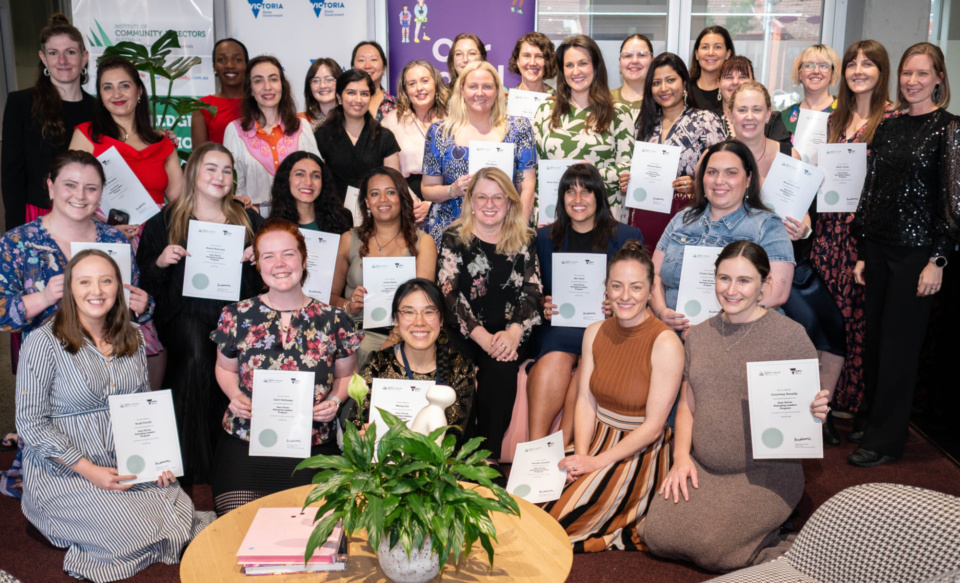
Burnout costing billions in the NFP sector
Posted on 11 Dec 2025
Community Directors trainer Jon Staley knows from first-hand experience the cost of ignoring…
Posted on 17 Jul 2025
By Matthew Schulz, journalist, Institute of Community Directors Australia

Leaders in the not-for-profit world agree that organisations must think beyond financial constraints and consider whether a merger will boost capacity, match existing cultures and meet the mission.
For decades, mergers have been touted as a solution to challenging conditions for not-for-profits and charities, but the country’s top thinkers in the area suggest careful consideration is needed.
“A key issue is considering the merger in terms of whether broadening your services through a merger is as useful as increasing your capacity within your current services,” the University of Western Australia’s Professor David Gilchrist said.
Charities Minister Andrew Leigh argued that while “there can never be too many charities” resources should be shared where possible, the Australian Charities and Not-for-Profits Commission’s (ACNC’s) Commissioner Sue Woodward stressed that mission should take precedence over merging, and Community Council for Australia CEO David Crosbie flagged the biggest barrier to mergers as “ego”, not organisational effectiveness.
"The cultural differences between organisations can make or break a merger."
Glichrist – head of the UWA’s Centre for Public Value – said organisations exploring a merger must ensure they:

Gilchrist warned that in the commercial world an estimated 80 per cent of mergers failed to deliver the desired result and said he expected that the not-for-profit world was no different.
“In the commercial world, we know that most mergers don’t return the expected outcome. In the not-for-profit sector, I suspect that outcomes are similar, or even worse possibly due to a lack of capital investment.
“Mergers in the not-for-profit and charitable sector are similar to those in the commercial world in one crucial way: the cultural differences between organisations can make or break a merger,” Gilchrist said.
“Understanding those cultural elements, and how you're going to manage that cultural transition over an extended period, is crucial. Otherwise, you risk just creating a bigger problem than the one you started with.”
Our Community group managing director Denis Moriarty – who heads the parent company of the Institute of Community Directors Australia – said he believed the ongoing funding squeeze and competitive environment for the nation’s 600,000 not-for-profits and estimated 64,000 registered charities was likely to prompt more to consider mergers, especially among the nation’s bigger operators.

Those organisations are seeking efficiencies through sharing resources, leveraging technological advances such as artificial intelligence, and forging collaboration on a bigger scale.
“Those able to continue operating independently – and avoid merger temptations – will still need to collaborate effectively with their sector counterparts to best achieve their missions,” he said.
He suggested more mergers are likely, in line with overseas trends. In the UK, for instance, charity mergers are up 90 per cent on the previous year, based on data from the regulator there.
“The stark reality of increasing costs has meant charities are looking for economies of scale and merging with larger organisations with greater access to resources,” the head of charities at consultancy RSM, Nick Sladden, told Consultancy.uk.

Charities Minister Andrew Leigh, in response to questions from Community Directors this week, stood firm in his view that the number of charities was not a problem.
“I will never hold the view that there can be too many charities. But I would encourage those thinking about establishing a charity to consider examining if there is an existing organisation to share expertise and resources with.
“We want more Australians to set up charities because they’re the foundation of a strong community. That’s why it’s vital charities, businesses, individuals and government must work together to ensure giving, volunteering and participation in Australia is strengthened.”
His view mirrors the ACNC’s official stance – outlined in this position paper – which is that there are not too many charities, and he suggests “the underlying concern people have is with the number of charities they feel are doing 'the same thing', duplicating efforts and competing for the same donations and funding.”
While the paper accepts there is some duplication, ACNC commissioner Sue Woodward said the real question for charities was how well they were achieving their goals.
“To maintain strong governance, it is critical that charities regularly assess their efficiency and effectiveness,” Woodward said.
“This may mean organisations consider whether it would be beneficial to collaborate on projects or share resources as a way to improve efficiency and effectiveness.”

She said the ACNC’s Charity Register was a good early port of call for organisations seeking to collaborate, as it allowed groups to search for like-minded charities by program and location.
“A charity’s committee or board should always pursue the best ways to advance its mission, its purpose.
“Some charities may decide the best path for them is to merge with another charity that has similar purposes, beneficiaries and activities. It is ultimately a decision for the board or committee, and there is no requirement to merge.”
Gilchrist said the idea that more charities and NFPs should amalgamate for the sake of efficiency was a common trope that wasn’t based on facts and needs.
“I remember when I co-wrote the very first Australian Charities Report [for the ACNC] back in 2013, and one of the first things people said was, “We’ve got too many charities.”
And I remember responding, “I guess we’ll all be better off once Woolies and Coles run all the supermarkets.”
“I don’t think the question ‘How many charities should we have?’ is even valid. Every charity operates within and is engaged with its own community, and what we don’t want is for charities to become so big they can’t engage with that community anymore.
“We know the most effective charities are the ones making decisions at the coalface, not in the national capital.
“The questions we ask should focus on whether we’re delivering services and support in line with community need. That’s the real question.”
“We’re not asking about profitability. We’re talking about income and turnover and not about the service mix gap, that is who is not receiving services.
“We just report how many services we provide. We don’t ask how much philanthropy we need, or whether that philanthropy is going to be funded by government, or what that means.”

The Community Council for Australia (CCA) has been examining the NFP merger issue in Australia for more than a decade, and it says discussing mergers can trigger strong divisions.
CCA chief executive David Crosbie admitted to Community Directors: “My record on mergers is not good.”
“I’ve tried three times to set up mergers that I thought would create stronger and more effective programs and services. In all three cases I failed. In talking with my peers, including Rev Tim Costello [the chair of CCA], my experience was far from unique.”
“CCA undertook some work 10 years ago in partnership with key organisations to promote the value achieved in successful mergers, using case studies from our sector.”
As part of that work, the organisation hosted high-level forums across Australia and produced the 2015 report Owning Our Future: Mergers and collaborations.
“We expected the report to be well received. It wasn’t. Some people actually rang up and abused both me and Tim for promoting mergers. One sector leader of a large federated organisation even wrote a long letter arguing that CCA was deliberately undermining federated organisations as a way to increase donations to World Vision [where Costello was CEO].
“The fundamental point to make about mergers and collaborations is that if we’re truly committed to the purpose of our organisations, considering how best to achieve that purpose should be part of our regular planning.
“Where the purpose could be better achieved through a merger or collaboration, I believe we have a responsibility to consider the options and work through barriers for the sake of the communities we serve.
“In my experience, most of the barriers to mergers and collaborations are about ego more than organisational effectiveness.
“Reflecting on the report 10 years later, I think it’s even more relevant today than it was when it was written”.
The report says, “Merger may be a dirty word for many, but that should not stop consideration of possible consortia, partnerships, and collectives.”

Five to six per cent of not-for-profits and charities merge each year, and extrapolating from those figures suggests that thousands of organisations consider merging or acquiring other NFPs each year.
According to the Australian Institute of Company Directors’ (AICD’s) latest NFP study – released in March – 17 per cent of NFPs expect to discuss merger proposals in the coming year, while five per cent were engaged in one at the time of the study. Seven per cent of groups put the odds of a merger in the next two years at 50-50.
The figures in the AICD study represent a significant reduction in the proportion of organisations discussing mergers, which was as high as 30 per cent in 2019.
Meanwhile, an ICDA study from 2020, Not-for-profit Governance Roadmap, showed health, community development and sport and recreation groups were the most likely to merge, while education organisations were the least likely.
It found the larger the organisation, the more likely it was to conduct a merger. While four per cent of groups with less than $1 million in revenue had merged, that figure tripled to 12 per cent for organisations earning more than $10 million.
The ICDA study also found that an organisation’s financial health was largely irrelevant to whether it merged, despite the commonly held belief that financial pressures are behind many mergers.
It suggested that the main reasons for merging include meeting the mission (35%), maintaining or increasing market share (24%) and broadening the range of services on offer (22%).

Perhaps one of the biggest investigations into merger trends is the 2018 landmark study Mergers, Amalgamations and Acquisitions in the Australian Not-for-profit Human Services Sector, produced by RMIT University and CPA Australia.
It found the main benefits from mergers were:
Organisations could also bolster their reputation and competitiveness, win more grants and increase their social impact with an effective merger, the study found.
Despite the estimates, exact merger numbers are unavailable, with the regulator tracking just a small proportion of mergers in its annual reports.
In response to questions from Community Directors Intelligence, the Australian Charities and Not-for-profits Commission (ACNC) described charity mergers as “not common”. It revealed that of the charities that voluntarily deregistered each year, only a small proportion gave “mergers” as the reason. In the past five financial years, mergers have numbered:
For context, in 2024, the 148 mergers were among 1,176 voluntary revocations, with other reasons for revocation given as shutting down (916), losing charity entitlements (77) or deciding to no longer operate as a charity (34).
The ACNC noted that the numbers could be skewed by bulk applications, such as where dozens of charities merged with a single large peak organisation. It’s possible that this – rather than a merger blitz – is the reason for the apparent trebling of merger numbers in 2023.
New laws are likely to increase transparency of charity mergers.
The Australian Competition and Consumer Commission (ACCC) has introduced a new merger control scheme, which came into effect from July 2025, and will be mandatory from January 1, 2026.
Until now, it hasn’t been compulsory for organisations to seek permission for a merger from the ACCC, or to notify it of an intention to merge. Under the new rules, notification will be mandatory for businesses and some charities that meet certain revenue or asset thresholds.
Notification is mandatory if:
The ACCC told Community Directors that charities were able to seek a "waiver of notification" in some circumstances, and that while it had not considered many charity mergers, it had been involved in "some matters" involving not-for-profits. It's expected to make information on trends available when the new rules have been in force for some time.
Gilchrist said he believed that in any merger, organisations should ensure they were able to maintain or improve service, describing this as a matter of “sustainability”.
“I’ve been talking about sustainability for a long time, but in different terms than how most people in this sector talk about it. Sustainability isn’t about whether an organisation survives. That kind of survivorship isn't relevant.
“Charities and not-for-profits are tools for a purpose. They’re not an end in themselves the way commercial entities are. BHP exists to increase shareholder wealth. There’s nothing wrong with that. But charities exist for a purpose, so sustainability should be linked to that purpose. Sustainability should mean the system can continue to deliver the quantity and quality of services at the right time.”
He said the number of charities was not a good measure of whether organisations were achieving that purpose.
“The fact that we have the same number of charities next year is not a sign of sustainability. It would be incredibly useful if we had data about which organisations terminate each year, and which ones are newly registered.”
While the Centre for Public Value’s research showed charity numbers were increasing, it was still revealing “a reduction in capacity, even though the net number of charities might suggest otherwise,” Gilchrist said.
“Looking at income or the number of charities isn’t meaningful. We need to look at profit, and at the gap between services delivered and community need.”

Posted on 11 Dec 2025
Community Directors trainer Jon Staley knows from first-hand experience the cost of ignoring…

Posted on 10 Dec 2025
As a qualified yoga instructor who learned the practice in her hometown of Mumbai, Ruhee Meghani…

Posted on 10 Dec 2025
Anyone working in an organisation knows it: meetings follow one after another at a frantic pace. On…

Posted on 10 Dec 2025
Stressed, overwhelmed, exhausted… if you’re on a not-for-profit board and these words sound…

Posted on 10 Dec 2025
The Institute of Community Directors Australia trains over 22,000 people each year, which gives us…

Posted on 03 Dec 2025
Many not-for-profit (NFP) board members in Australia are burnt out, overwhelmed and considering…

Posted on 26 Nov 2025
A roll call of Victoria’s brightest future leaders has graduated from a testing and inspiring…

Posted on 12 Nov 2025
At the Institute of Community Directors Australia, we believe that stronger communities make a…

Posted on 12 Nov 2025
Like many Community Directors members, Hazel Westbury is a community leader who isn’t easily…

Posted on 11 Nov 2025
I’ve seen what happens when fear of conflict wins out over taking a principled stand.

Posted on 11 Nov 2025
‘It’s not a question of enough, pal. It’s a zero-sum game. Somebody wins and somebody loses’.

Posted on 11 Nov 2025
Progressive economic Richard Denniss believes the constant hunt by governments for the political…